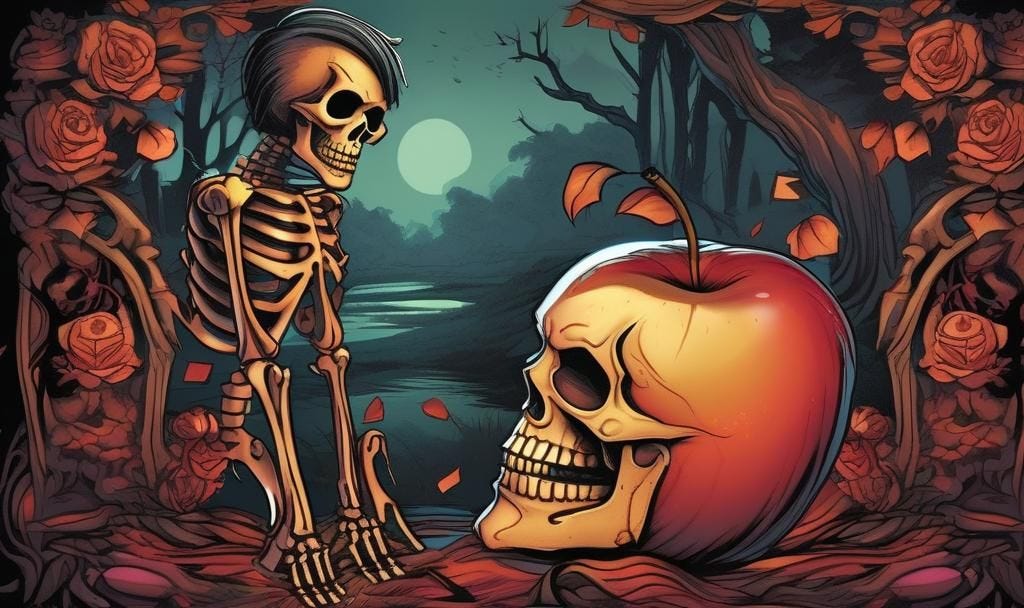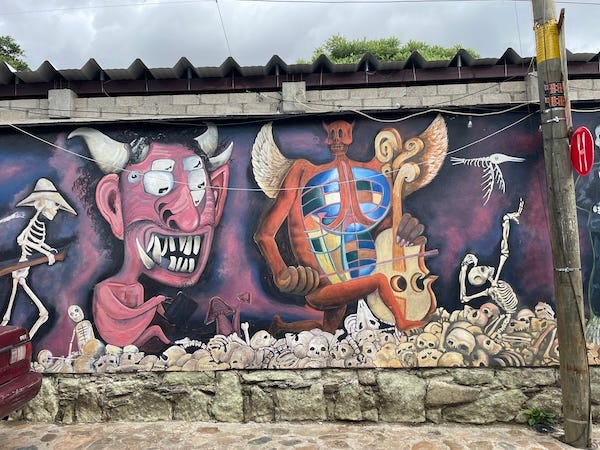Our microbiome is with us from cradle to grave
Exploring the dark side of our microbiome, our necrobiome 💀 or a look at life through death
Many traditions worldwide have festival days to honor the dead; often, they are celebrated in the late summer or fall. For several, these days at the end of October and the beginning of November are a time to mark the end of harvest season. Growth and food abundance are over. We watch plants die back and leaves fall in brilliant color. We head into the leaner, darker time of winter. What a perfect time to wonder if the veils between the living and dead are as thin as we reminisce about those who came before. In a way, we allow ourselves this time to acknowledge and celebrate death and decay, something most people prefer not to think about. These celebrations are often full of revelry that is bright in color and mirth. And yet the fun with spooks and skeletons also serves to remind us that one day, we will be skeletons, for death is part of life. And life is very much part of death.
When I am teaching vinegar-making, I like to tell the story of the life cycle of an apple. In the winter, the tree is dormant. The little buds are closed tight, protecting the tree’s hope and future contained within. The energy-making leaves and the flowers that promise apples and seeds wait. Spring comes with light and rain. The buds swell and burst into bloom. These flowers already have the yeast and acetic acid bacteria that will ferment our desired product. Or, without us, complete the ancient cycle of life, death, decay, and life.
The sun, rain, fungi, and earth continue to nurture our tree. Pollinated flowers become apples that grow through the summer. In the autumn, they fall to the ground. As soon as that fruit hits the ground, everything changes. There is a microbial frenzy that begins to consume the sugars in that apple. The yeast and lactic acid bacteria work on the sugar. The yeast creates alcohol in the process (hard cider), and right behind them, the acetic acid bacteria are ready to consume that alcohol, converting it into acetic acid. Hello, vinegar! But wait. Acetic acid bacteria are crafty. They are not going to roll over and die because their preferred food is gone, which incidentally is what the yeast did. Instead, they begin to consume the very acetic acid they made, this time converting to water. Thereby recycling back into the system. All but that little seed has returned to the system, and if all goes well, it will grow into another tree. Our human story, in a way, is not much different.

In honor of Halloween (with its roots in Samhain) and Dia de Los Muertos: Let me introduce you to the necrobiome.
Our gut microbiome is remarkable. It is the most densely populated microbial environment in our human body, and some research suggests it contains one of the highest microbial concentrations recorded in any of Earth’s habitats. (For those of you who like numbers, it’s estimated to be between 10^10 to 10^11 cells per milliliter.)
Do they die when we die? Nope. They live on without us as our legacy—microbially speaking, anyway. If we aren’t cremated, we, along with every other living being on this planet, are recycled back into the system. We leave a microbial legacy that lives on for months, sometimes years after our soft tissue has rotted away and we are a skeleton. What isn’t clear is if they are active or in stasis, waiting for a new host to come along.
I have always known I wanted to be simply planted in the ground when I die. I suspected I would feed a tree. Now I am sure that I will, or at least some daisies. Turns out the phrase, “I’ll be pushing up daisies” is not far from the truth. Plant me in the earth and I will ferment.
When we die, our heart and lungs, who have worked in tandem tirelessly to circulate oxygenated blood throughout our bodies, cease. Cells without oxygen begin to digest themselves, a process called autolysis.[1] The enzymes contained in those cells start to break down the components that make up the cells. The products, or bits that come from this breakdown, make excellent food for our symbiotic bacteria, now our necrobiome, previously known as our microbiome. Those bacteria no longer have the steady meals that we sent them, and our immune system is no longer there to keep them in check. Our gut bacteria have at it and spread throughout our organs and soft tissue. With us, their host gone, they reproduce like crazy as part of their exit strategy in hopes (guessing here) that some survive to find a new host.
If we are buried in the ground, assuming no embalming chemicals have been used, our microbes create a soup of us and them, which oozes into the soil. Here, they meet the local community of soil microbes. There is a mingling of these very distinct groups of microbes followed by a bit of a race to see who dominates. Your microbes, renamed by the science studying such things as carcass microbes, are accustomed to warm temperatures and regular food probably find the cold ground a bit of a shock. This is why we might assume that it is game over for team microbial legacy, but this study suggests that your microbes collaborate with the native soil microbes to decompose your body.
These mixed communities have higher respiration rates compared to soil microbes or carcass microbes alone, meaning better ammonification and denitrification. What does that mean? That the us that is them and the us that was us is an important part of the nitrogen cycle.
Nitrogen is an essential nutrient for life, but most nitrogen is locked up as atmospheric gas that can’t be used by plants. Decomposing microbes are critical in recycling organic nitrogen such as protein into ammonium and nitrate that plants and microbes (there they are again) can use.
Living animals, ourselves included, are, in a way, a chokepoint for nutrient and carbon cycles in that we live our lives moving about accumulating nutrients and carbon. We do poop our out microbial-rich, nutrient-dense-waste, which in the right setting heads back into this cycle, but for the most part, this carbon and nutrient is locked up until we die. At this point, we deposit the whole business in one spot. While the microbes are working, so are the insects (and scavengers for animals) who help redistribute those nutrients. The microbes often go along for the ride. The microbes are ever active, making our bodies into ever smaller, more bioavailable forms for life to continue to thrive.
This is no small thing, if you will allow me this tangent, this is why the nitrogen from salmon DNA is found in trees. The ancient forests across the Pacific Northwest can owe much of their richness to salmon, both from the salmon carcasses the bears drug to the forest to eat. The scraps are left rot at the tree’s bases, where microbes bring those nutrients into the soil, same with that bear’s poop and eventually its dead body. North of where I live, the Great Bear Rainforest receives 80% of its nitrogen from salmon.
So when you celebrate Halloween tonight or day of the dead tomorrow and Saturday and you see ghouls, skeletons, zombies, you can think of your microbiome.
I have to say knowing little bits of me will ferment and become part of something else is comforting. When I shared this post with Christopher said, “What strikes me is how our immune system is completely dependent on our microbiome, but it’s also gatekeeper. It’s like our immune system is keeping the inmates at bay until the power goes out, all the cell doors open, and they take over.”
Okay, that is creepy.
🎃 Happy Halloween 👻
1 You may know autolysis from fermentation. This occurs when the microbes self-digest. In miso, it is the koji mold that autolyzes, creating proteins, nucleic acids, sugars, and more. This contributes to the great flavor of miso. Wine, cider, and beer makers know this is what happens to the yeasts when left sitting on the lees (spent yeast). This can be done on purpose for smooth flavors, as in Champagne, or it can be seen as a fault. Like all fermentation, it is what you aim for.







Thank you very much for for your newsletter. It was interesting and somewhat comforting. Happy Halloween!
Oh, Kirsten , this sensitively written article reminds us to be proud of how we can indeed give back to the Earth! The topic of home burial is new to many so I am attaching a link. Spoiler alert: we all will have an end of life experience so might as well become educated to the facts and continue on our fermentation path! https://www.romemonuments.com/home-burials